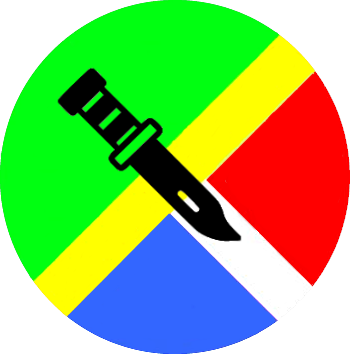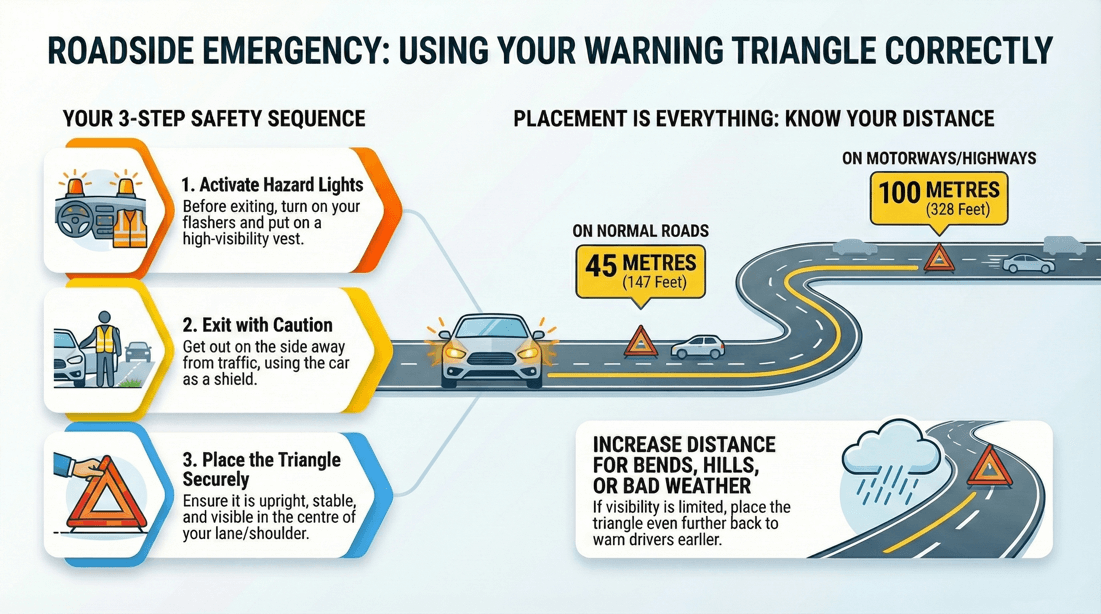
Warning Triangle
Safety triangle. Emergency triangle. Survival triangle. Caution triangle. Red triangle. Hazard triangle. Reflective triangle.
? Questions:


? When to use a Warning Triangle ?
When to Use a Warning Triangle
Vehicle Breakdown: If your vehicle breaks down on the road, especially on a highway or busy road, place a warning triangle to warn other drivers of the potential hazard. Accident : If you are involved in an accident and your vehicle is obstructing traffic, use a warning triangle to alert other drivers. Emergency Stops: If you need to make an emergency stop for any reason, use the warning triangle to signal to other drivers that your vehicle is stationary. Low Visibility Conditions: In case of low visibility conditions, such as fog , heavy rain , or snow, use a warning triangle if you need to stop on the roadside.
How to Use a Warning Triangle
Place the warning triangle at least 45 meters (147 feet) behind your vehicle on normal roads. On highways, position the triangle at least 100 meters (328 feet) behind your vehicle. Ensure the triangle is placed on the same side of the road as your vehicle, ideally in the center of the lane or shoulder.
Always switch on your hazard lights before exiting the vehicle. Wear a high-visibility vest if you have one, especially on highways or in low visibility conditions. Exit your vehicle safely, ideally on the side away from traffic.
Place the triangle in an upright position, ensuring it is visible to oncoming traffic. Check that it is stable and not prone to falling over due to wind or passing vehicles.
Additional Tips
Use Multiple Triangles: In some situations, such as a vehicle with a trailer or a long vehicle, using two warning triangles (one closer to the vehicle and one further back) can provide additional warning. Follow Local Regulations: Be aware of and follow any specific local or national regulations regarding the use of warning triangles. Some regions may have specific requirements for placement distances or additional safety equipment. Keep Accessible: Store the warning triangle in an easily accessible location in your vehicle, so you can quickly retrieve it in an emergency.
? H o w far, or at what distance should the Warning Triangle be placed from a car?
General Guidelines for Placing a Warning Triangle
On Normal Roads: Place the warning triangle at least 45 meters (147 feet) behind your vehicle. On Highways or Motorways: Place the warning triangle at least 100 meters (328 feet) behind your vehicle.
Additional Considerations
Curves and Hills: If you are on a curve or the crest of a hill, place the warning triangle far enough back so that it is visible to oncoming traffic before they reach the obstruction. This may be more than the standard distances mentioned. Poor Visibility: In conditions of poor visibility, such as fog or heavy rain , you may need to place the triangle further back to give drivers more warning time. Local Regulations: Always check local regulations as they may specify different distances or additional requirements for the placement of warning triangles.
Steps to Place a Warning Triangle
Before exiting the vehicle, turn on your hazard lights to alert other drivers.
If you have one, wear a high-visibility vest for additional safety, especially on highways or in low visibility conditions.
Exit the vehicle safely, ideally on the side away from traffic. Walk back the appropriate distance (45 meters on normal roads, 100 meters on highways) and place the triangle in an upright position. Ensure it is placed in the center of the lane or shoulder where your vehicle is located, and that it is stable and visible to oncoming traffic.
After placing the triangle, re-enter your vehicle safely, using the same precautions.
? Can I use more than one Warning Triangle?
Situations Where Multiple Warning Triangles are Useful:
Using multiple warning triangles can improve visibility for approaching drivers, especially in poor weather conditions, on winding roads, or in areas with poor lighting. Place one triangle at a greater distance from your vehicle and another closer to it to provide a graduated warning to oncoming traffic.
If your vehicle is stationary on a road with traffic coming from both directions (e.g., on a two-way street or road), using two triangles, one on each side of the vehicle, can warn drivers approaching from either direction.
On highways, motorways, or roads with multiple lanes, placing multiple triangles at different intervals can give drivers more time to react and change lanes or slow down.
Guidelines for Placing Multiple Warning Triangles:
Place the first warning triangle about 50 to 100 meters (approximately 165 to 330 feet) behind your vehicle on standard roads. On highways or faster roads, place the first triangle 200 to 300 meters (approximately 660 to 980 feet) behind your vehicle. For increased visibility , place a second triangle halfway between the vehicle and the first triangle.
On two-way roads, place one triangle in front of your vehicle (facing oncoming traffic from the front) and one behind your vehicle (facing oncoming traffic from the rear).
Ensure you are visible when placing the triangles, especially at night or in low-visibility conditions. Wear a high-visibility vest if you have one. Place the triangles on stable ground where they won’t be easily knocked over by wind or passing vehicles.
? What if I don't have a Warning Triangle?
Alternative Safety Measures:
Turn on Hazard Lights : Activate your vehicle’s hazard lights immediately to make your vehicle more visible to other drivers. Use Road Flares: If you have road flares, place them around your vehicle to warn other drivers. Flares can be especially effective at night or in low-visibility conditions. Reflective Clothing: Wear a reflective vest or bright clothing to make yourself more visible when exiting the vehicle. Use Other Reflective Items: Place any other reflective objects you have (such as a reflective emergency blanket or tape) behind your vehicle to warn oncoming traffic. Raise the Hood: Open the hood of your car to signal to other drivers that your vehicle is broken down and not moving. Place a Reflective Object or Cloth: Attach a reflective object or bright cloth to the antenna, door handle, or side mirror to make your vehicle more noticeable. Stay Safe: Move to a safe location away from the flow of traffic, if possible. Stand well off the road and behind any barriers if available. Call for Help: Use your mobile phone to call roadside assistance or emergency services if needed.
Steps to Follow:
Assess the Situation: Evaluate your surroundings and determine the safest way to alert other drivers and move to a secure location. Stay Visible: Ensure that any actions you take increase your visibility and that of your vehicle to approaching traffic. Use Your Phone: If you have a mobile phone, call for roadside assistance or emergency services. Many vehicles come with built-in assistance services like OnStar, which you can use to request help. Avoid Traffic Lanes: Do not stand in traffic lanes. Instead, stay off the road and in a safe area until help arrives.
? Is a Warning Triangle legally required?
Examples of Regulations by Region:
European Union: Most EU countries require drivers to carry a warning triangle and to place it behind their vehicle in the event of a breakdown or accident. United States: Requirements vary by state. Some states require commercial vehicles to carry warning triangles, while personal vehicles may not be legally required to have them. Canada: Regulations vary by province, but generally, commercial vehicles are required to carry warning triangles. Australia: Not all states require warning triangles, but they are strongly recommended, especially for commercial vehicles.
Why It's Important:
Safety: A warning triangle enhances safety by alerting other drivers to your stationary vehicle, reducing the risk of further accidents . Compliance: Not having a warning triangle when required by law can result in fines or penalties.
Recommended Actions:
Check Local Regulations: Verify the specific requirements in your country or region. Carry a Warning Triangle: Even if not legally required, it is a good safety practice to have one in your vehicle. Know How to Use It: Understand the proper placement and use of a warning triangle to maximize its effectiveness.
? Do I need to use a Warning Triangle in urban areas?
Legal Requirements:
Local Regulations: Check your local traffic laws to understand the specific requirements for using warning triangles in urban areas. Some jurisdictions may have different rules for urban and rural settings. Country-Specific Laws: In many countries, it is mandatory to use a warning triangle in both urban and rural areas if your vehicle breaks down or is involved in an accident.
Safety Considerations:
Visibility : Even in urban areas, a broken-down vehicle can be a hazard to other drivers. Placing a warning triangle enhances visibility and warns other road users of your presence. Traffic Flow: Urban areas often have high traffic density. A warning triangle can help alert other drivers to your situation and prevent accidents or traffic congestion. Nighttime and Poor Weather : In low visibility conditions such as nighttime or bad weather, a warning triangle can be particularly effective in ensuring your vehicle is seen by other drivers.
Practical Steps:
Placement: Place the warning triangle at a safe distance behind your vehicle to give approaching drivers ample time to react. The recommended distance is typically around 30-50 meters (100-165 feet) in urban areas. Additional Measures: Use your vehicle’s hazard lights and, if available, place other reflective objects or flares to increase visibility.
When You Might Not Need It:
Immediate Hazard Remediation: If you can quickly move your vehicle out of the flow of traffic (e.g., into a parking lot or side street), the need for a warning triangle may be reduced. Assistance Available: If emergency services or roadside assistance arrive quickly, they may take over traffic management, reducing the necessity for a warning triangle.